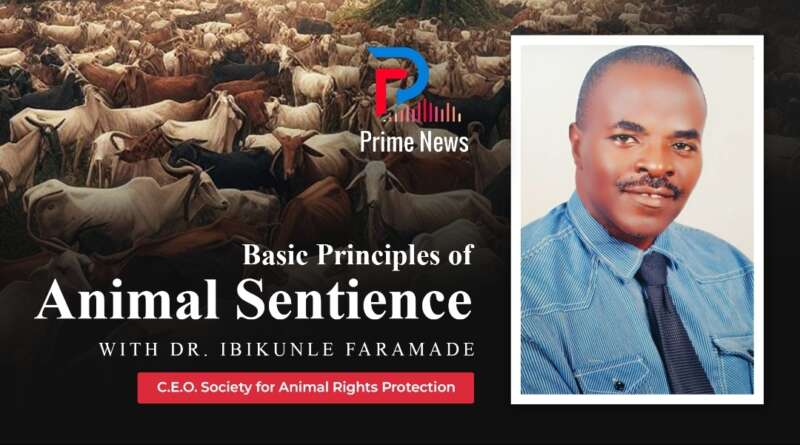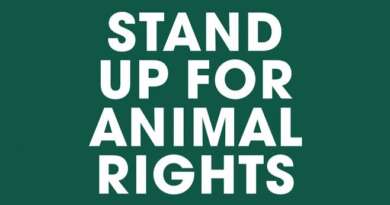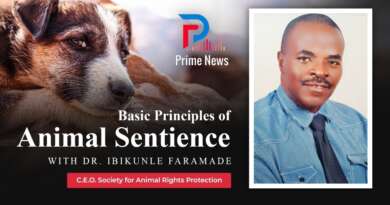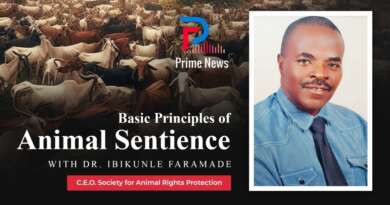Welfare Concerns for Wild Animals 2
By Dr. Ibikunle Faramade
…Continued
Natural resources exploitation and extraction processes also put enormous pressure on the welfare of wild animals. In many places where mineral resources are being explored or exploited, little attention or consideration is given to the survival, let alone welfare of the wild animals whose habitat suddenly turn to huge mining site. Before approval licenses are issued to prospective miners throughout the country, the impact of mining activities on the habitat of wild animals should be thoroughly assessed. The impact of mining on wild animal welfare is multifarious. There is massive deforestation leading to habitat fragmentation, disruption of the entire ecosystem, accumulation of heavy metals such as cadmium, lead, chromium, selenium, zinc to mention a few. Contamination of underground water with heavy metal, destruction of soil structure, depreciation of the quality of the flora, wild animal population instability occasioned by forced relocation due to high impact sound and echo which sends stressful signal to the animals. Disproportionate availability of complimentary pairs required for successful breeding activities. Disorientation of social groups and alteration of social hierarchy or peck order. These and more are some of the deleterious effects of mining on wild animal’s existence and welfare which requires urgent attention.
Pollution is another significant challenge to wild life. Pollution occurs as a result of the release of environmental contaminants into the air, water and soil, as well as the excess light, sound and heat from human activities. Poor management of household and industrial waste which are channeled directly or indirectly into wild life habitat has led to the death of many wild life. Many sea birds are injured or die due to the consumption of sharp objects, plastics etc. it was reported that the use of some analgesic e.g. diclofenac in the treatment of cattle prior to slaughter has led to the death of many vultures and other birds of prey who were attracted to the abattoirs by the leftover meat found in the surrounding leading to massive decline in population of such birds in the affected environment. The indiscriminate pollution of water bodies by industrial discharge of toxic waste or leaching of toxic chemicals from the soil (from fertilizers, herbicides etc) directly impinge on the welfare of wild animals who depend on these water bodies as their source of drinking water. This leads to immediate death or gradual pathologic change in such animals over time. Bio-accumulation of toxic chemicals may not necessarily lead to death immediately. It may have grievous effects on the reproductive potentials of the affected animals. Male and female may become irreversibly sterilized, pregnant females may abort or give birth to deformed newborns and lactating dams may lose their off springs. If the pollution of water bodies have these disastrous effects on terrestrial wild animals who depend on water bodies as their source of drinking water, the impacts of pollution on aquatic animals cannot be imagined. Water pollution affects oxygen concentration, increase turbidity, alter microbial population dynamics, destroy the aquatic micro flora and phytoplankton upon which aquatic animals depend. There is also alteration of salinity and disruption of the hydrogen ion concentration i.e. PH among others. Unfortunately, some of these aquatic animals that have been exposed to pollutants are consumed by humans as sea foods, bringing into the food chain various hazards, plagues and death.
Water pollution is therefore, a veritable danger to humans and wildlife (terrestrial and aquatic), a driver of eradication of species, a threat to sustainability and a hindrance to the achievement of sustainable development agenda.
Air pollution also poses grave danger to wild life. The release of exhaust (containing carbon soot etc) from vehicles and power generators which depend on fossil fuel impose serious environmental burden on wild bird. Sulphurdioxide and nitrogen oxides (another noxious gases from industrial complexes) lead to the formation of acid rain, which affects wild animals and their habitat around the world. Accumulation of greenhouse gases and its effects (especially, the rise in atmospheric temperature- global warming) thus affect the habitat of wild birds, negatively impact their migration routes, alter their reproductive biology and overall survivability. There is also a severe inter species competition and alteration of ecological dynamics that may push susceptible species into early extinction.
Because of the impacts of air pollution on migration routes and patterns, there is increased chances of transmission of diseases (including zoonosis) of which many feral birds are reservoirs. The spread of avian influenza and the roles of migration and wet lands readily comes to mind.

It is hereby advocated that strict compliance with extant laws should be enforced by the government at all levels. The National Environmental Standards and Regulation Enforcement Agency (NESREA), a parastatal of the Federal Ministry of the Environment in Nigeria, under whose watch the prevention of all types of pollution falls, among other mandate, is encouraged to increase their efficiency in the discharge of their statutory roles. The government has to be more stringent in the regulation of the use of plastics, encourage recycling possibly by attracting recycling companies with stimulating waivers that could increase the number of investor in that sector. The regulations bordering on the manufacture and use of agrochemicals should be enforced. All effluents should be appropriately treated and made nontoxic before their eventual discharge into the environment. Research into the production of more eco- friendly products should also be encouraged. More concerted efforts should be made to reduce or prevent oil spillage in oil producing areas in order to save the flora and fauna in that environment.
We should determine more than ever, to protect our wild life, promote their well-being and be conscious of their welfare in our own interest, through actionable policies, enforcement of extent laws and review of obsolete or ambiguous ones.
Concluded.
Dr. Ibikunle Faramade is a veterinary pathologist, sustainable development practitioner, animal welfare advocate and a lecturer at the Federal College of Animal Health & Production Technology, Apata. Ibadan. He’s the C.E.O of the Society for Animal Rights Protection, a non-profit and a non-governmental organization dedicated to the promotion of animal welfare, animal rights and prevention of cruelty to animals. animalrightsprotection2020@gmail.com , +2348028305284




